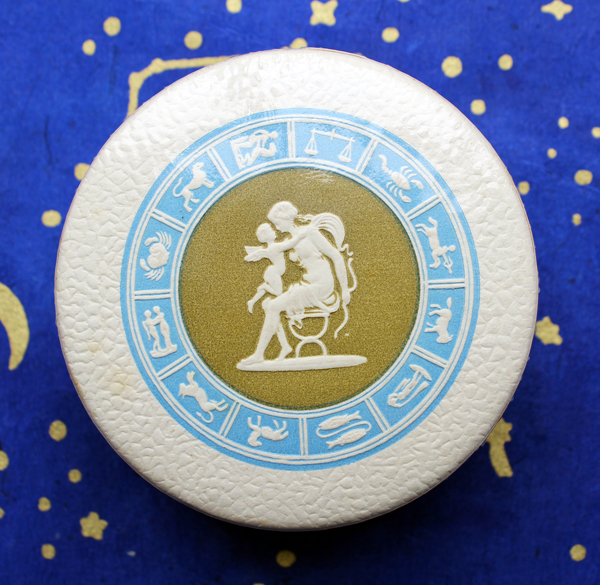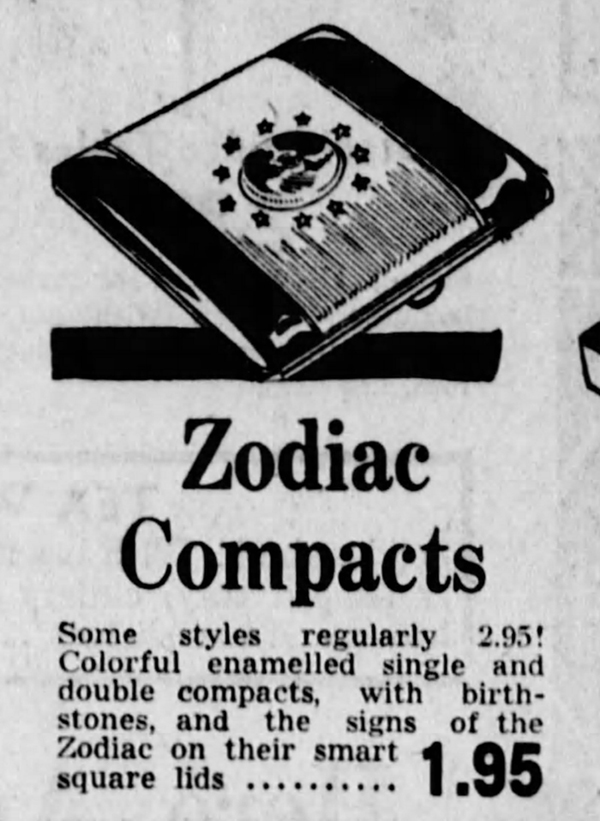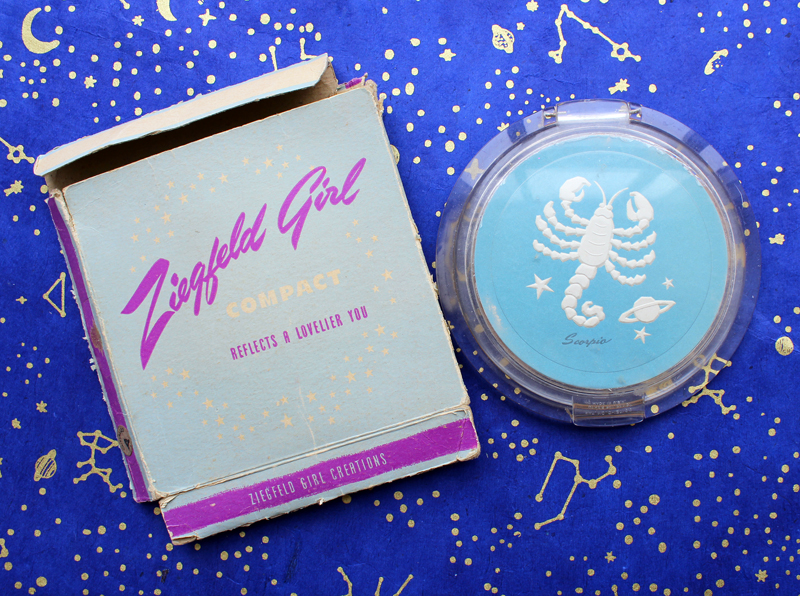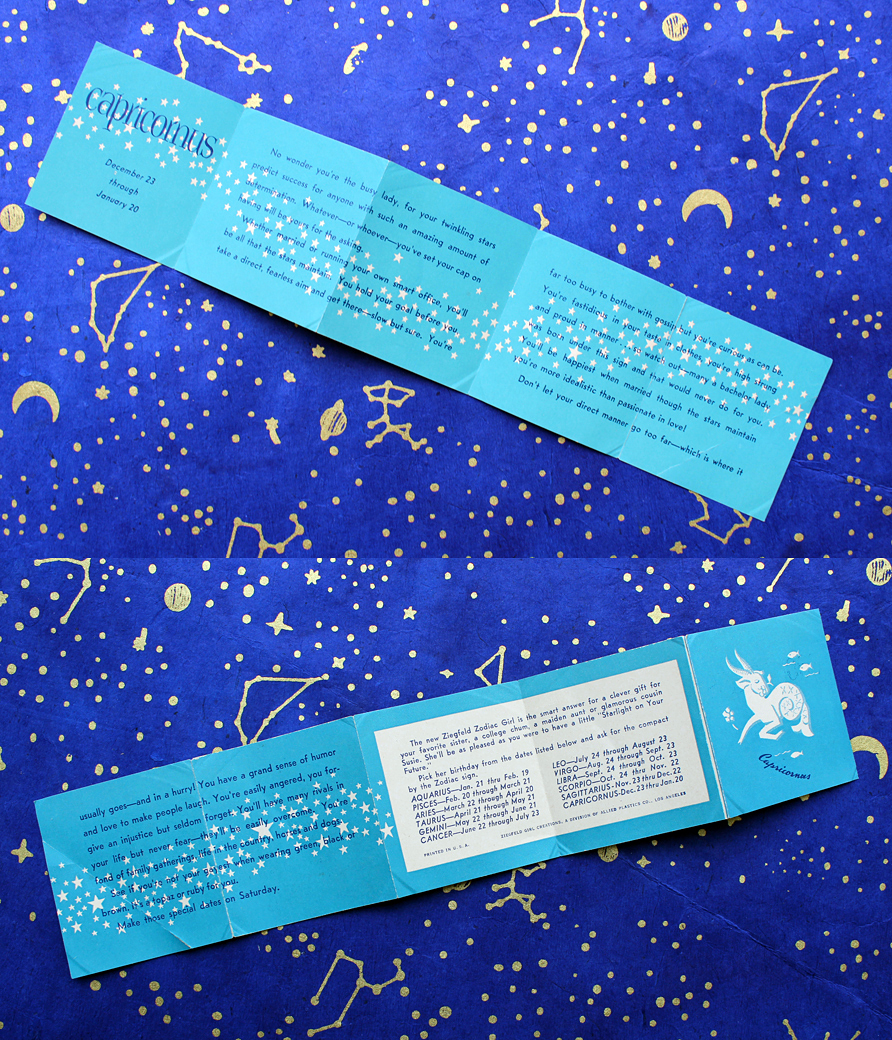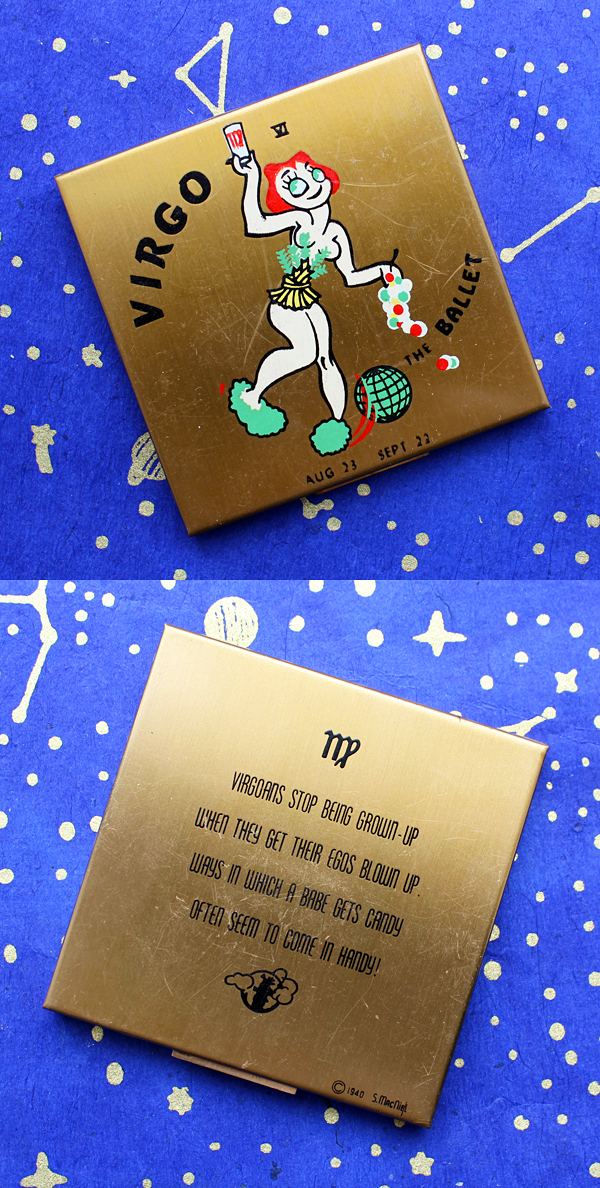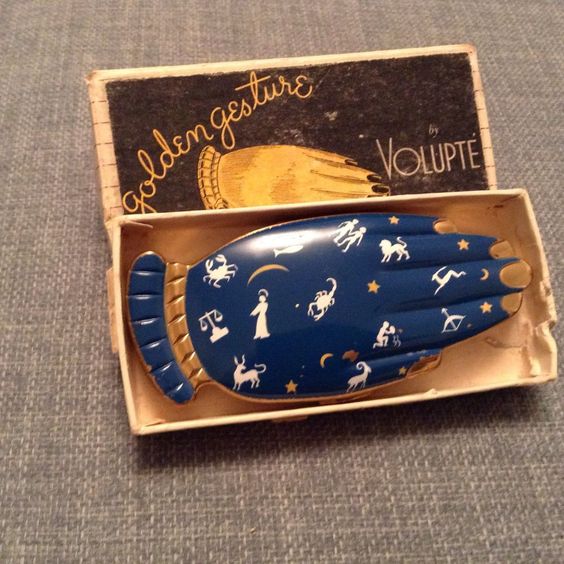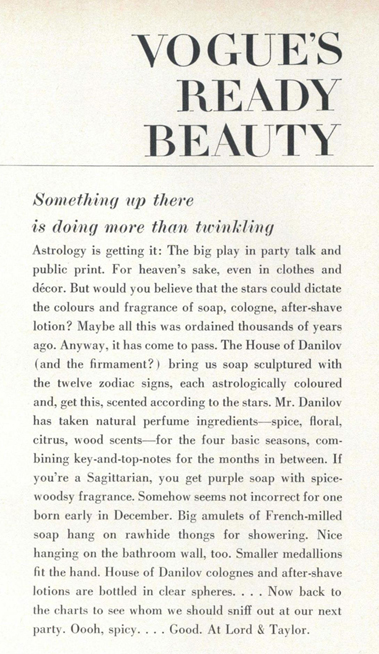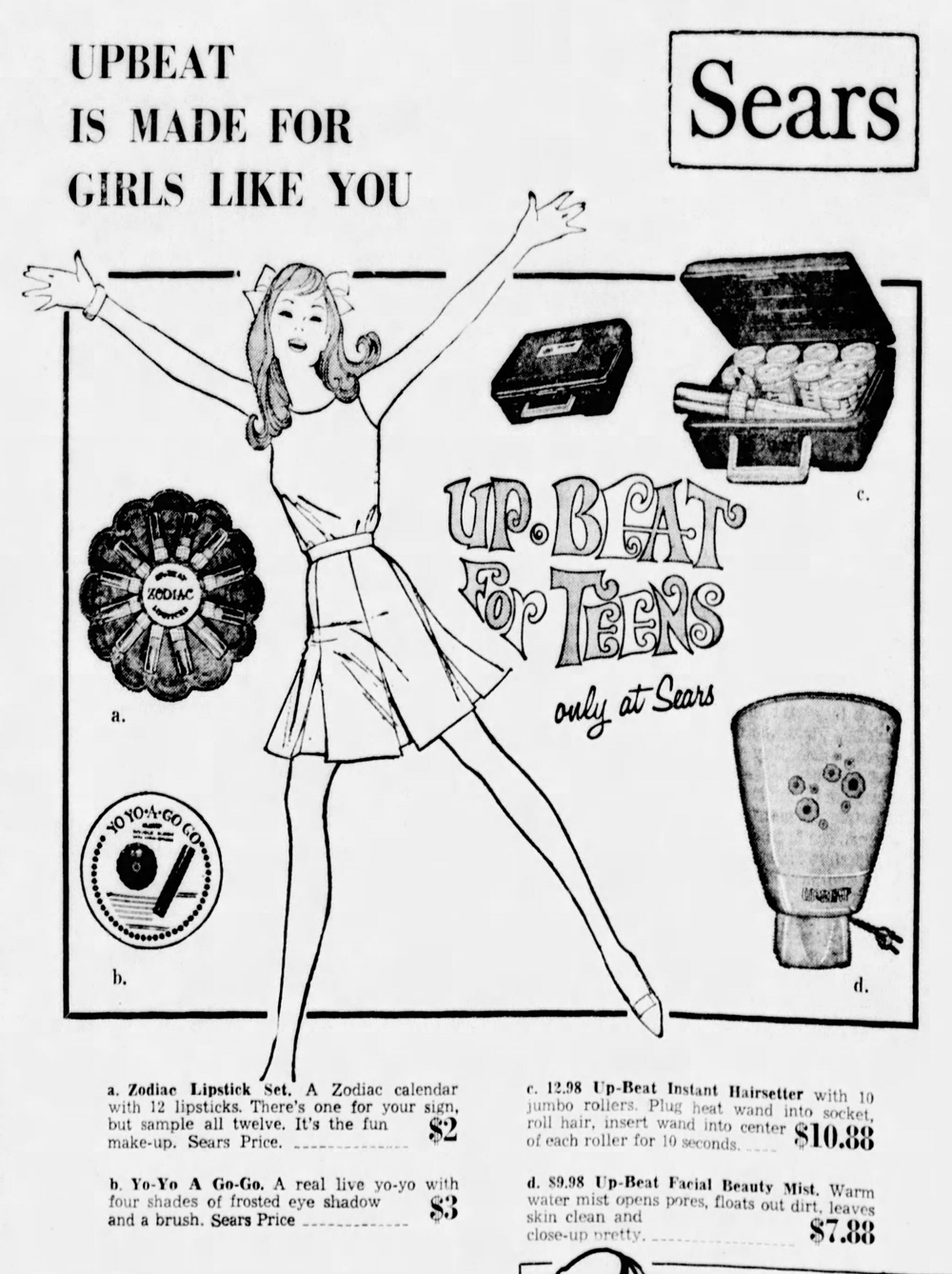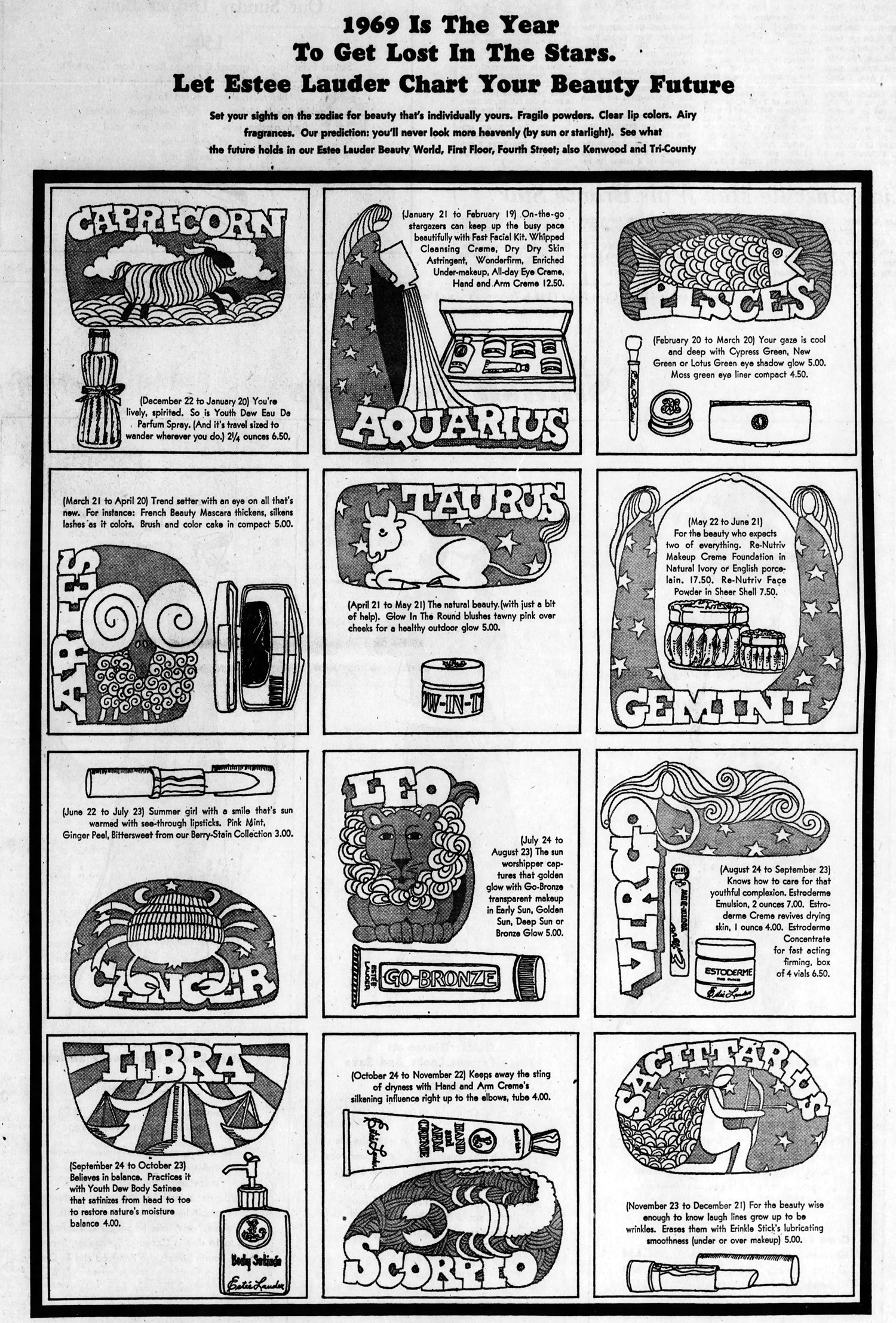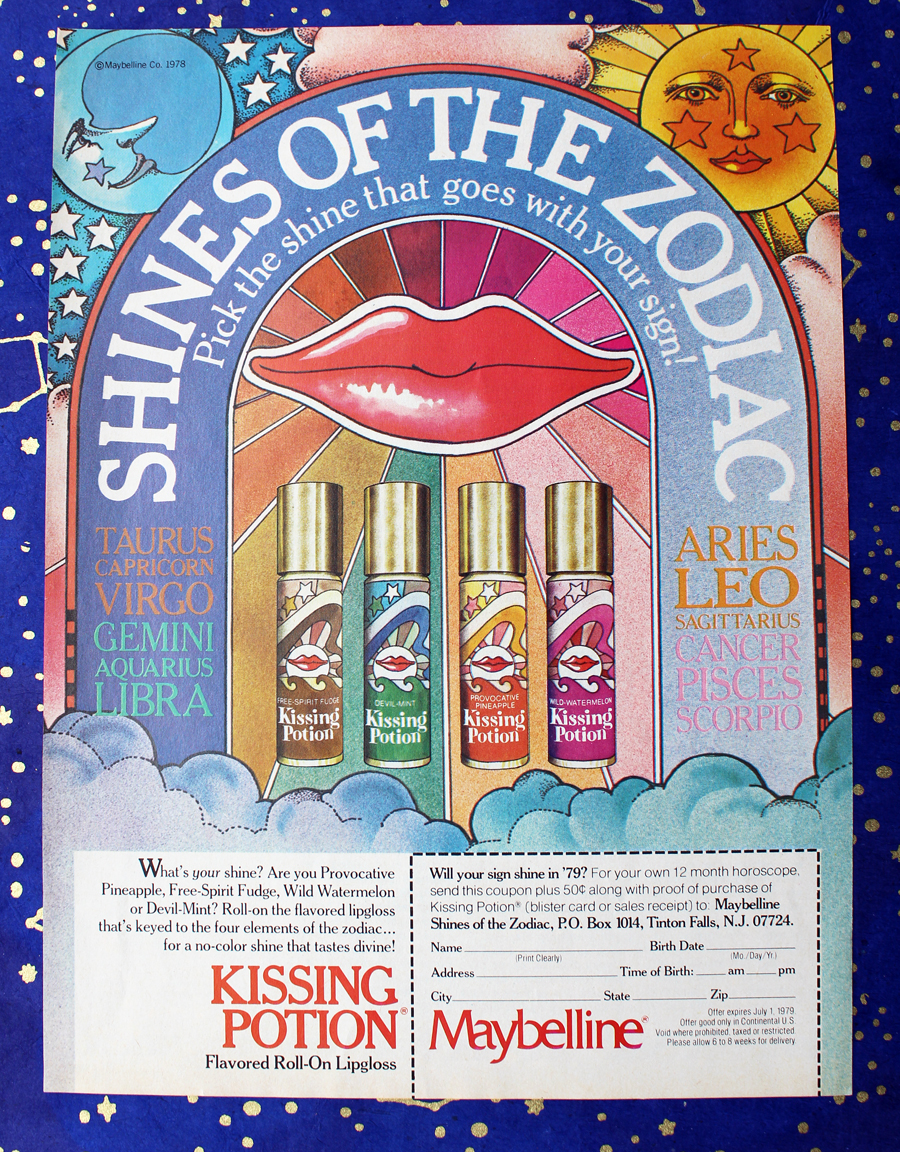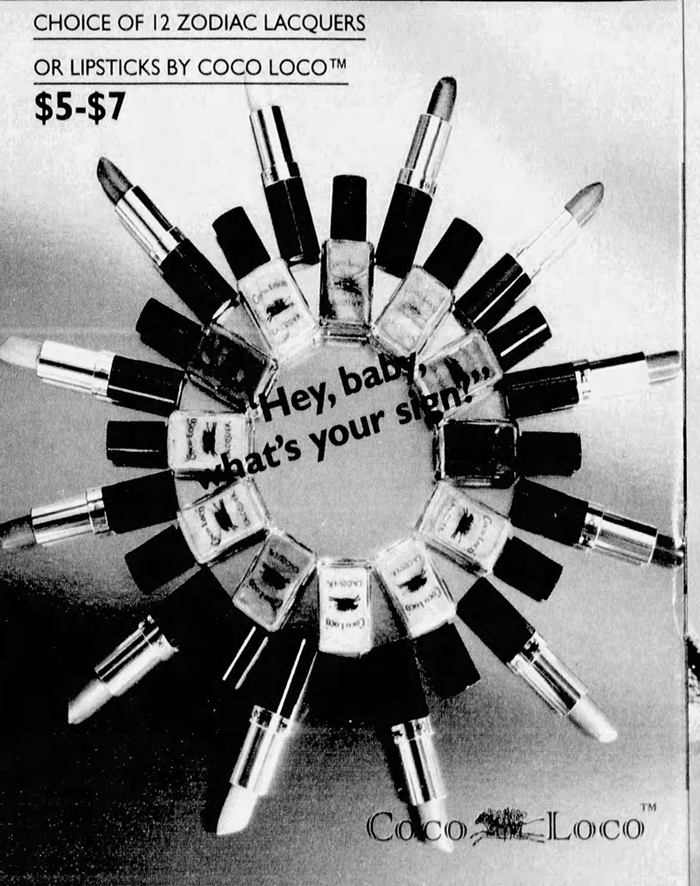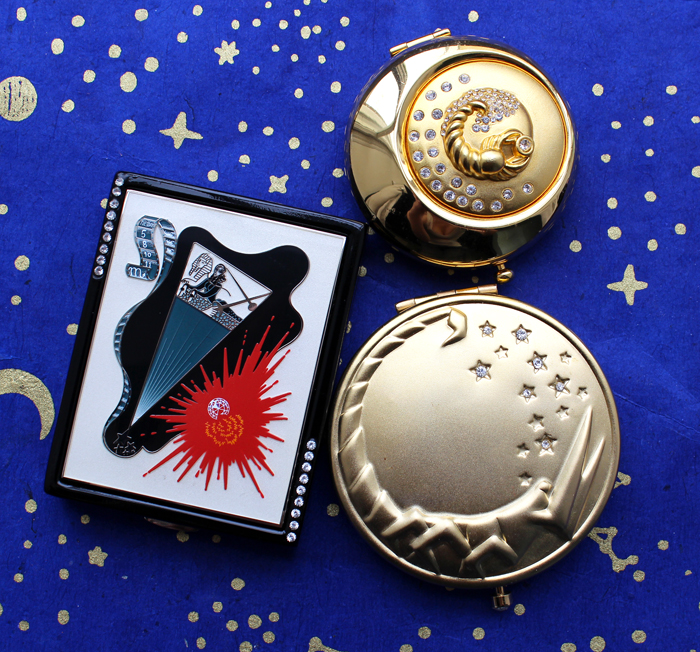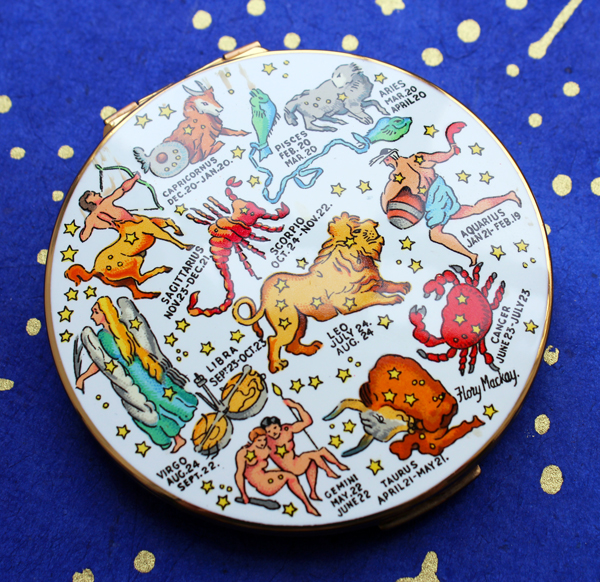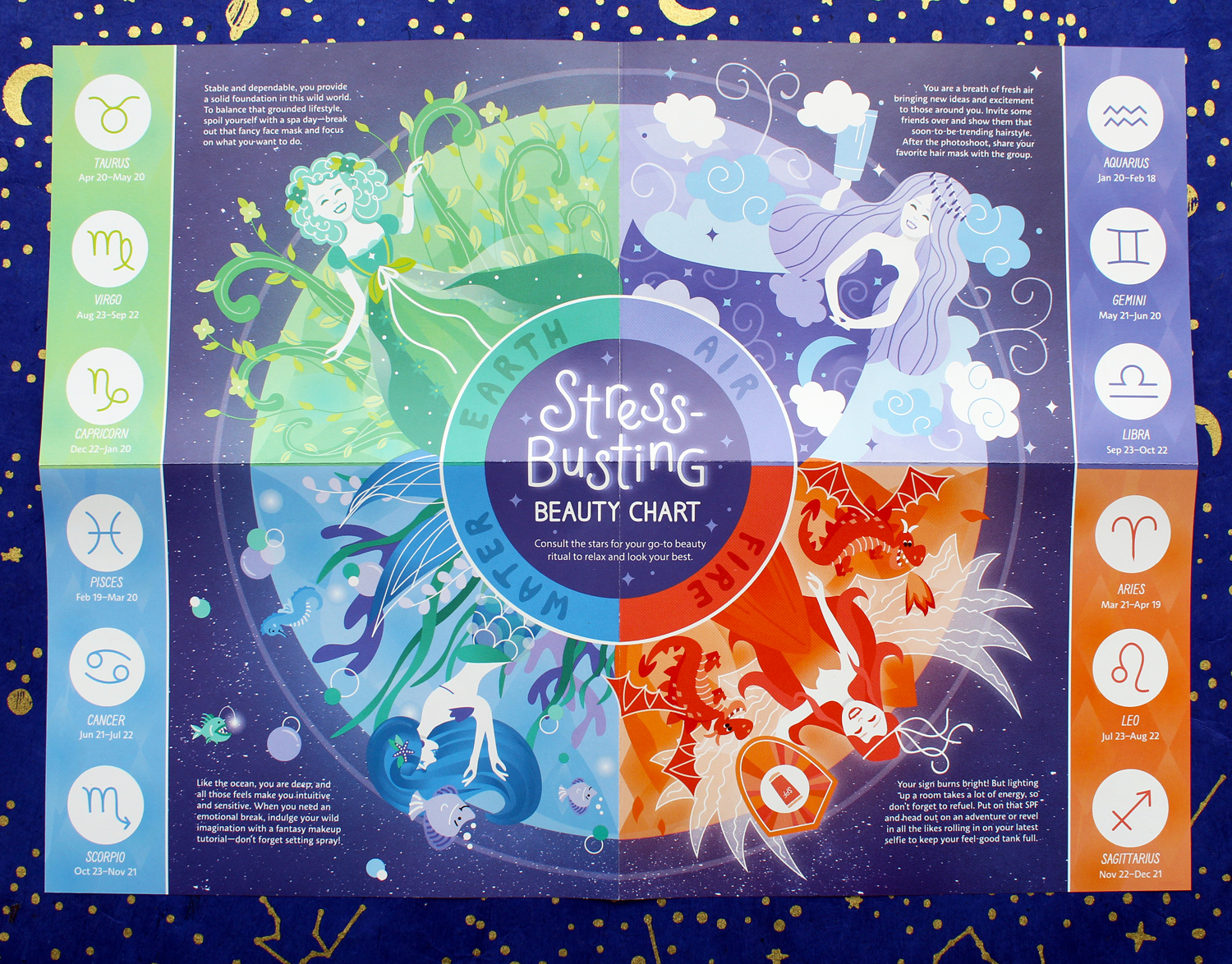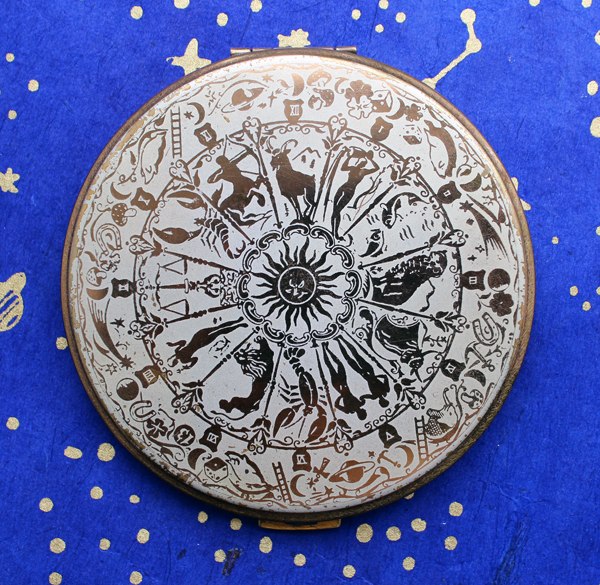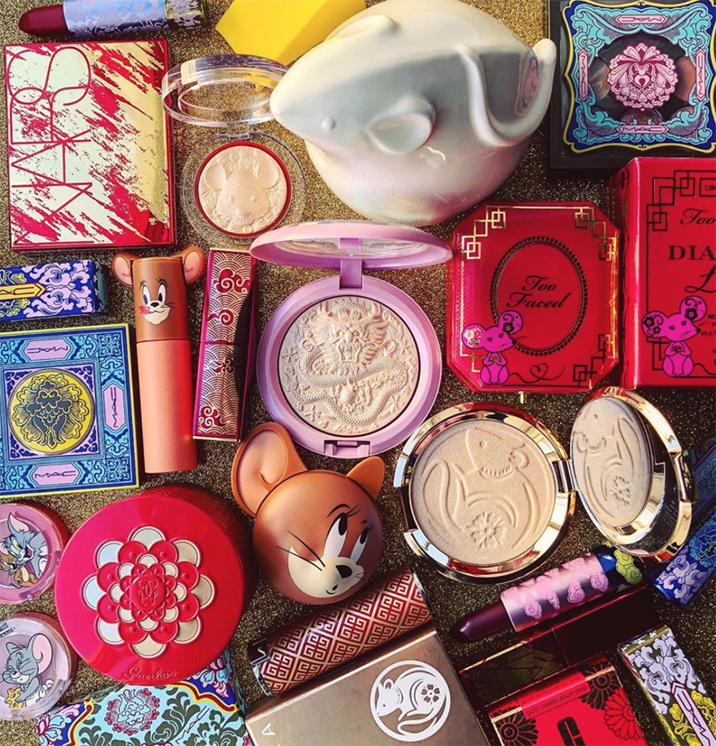Almost as much as flowers, fruit, and butterflies, the signs of the zodiac are leading choices for modern cosmetics collections and beauty inspiration. As a new sign season (Taurus) descends today, I thought it would be an appropriate time to provide a visual history of zodiac beauty and trace the ebb and flow of its popularity in the U.S. As we'll see, the two main components of this particular category (zodiac-themed packaging and beauty tips/makeup looks based on one's sign) and the reasons behind their prevalence at certain times really haven't changed much in the past 100 years.
The story arguably begins in the late 1600s in Europe, when British satire poet Samuel Butler suggested that women used beauty patches to indicate their sun sign. As Aileen Ribeiro explains in Facing Beauty, "According to astrology, certain areas of the face were governed by the signs of the zodiac – Capricorn the chin, Aquarius the left eye, and so on – so that patches placed on the face could echo this respectable link, this time equating such sites with emotions related to love and sexual invitation; this game, perhaps not taken seriously by women at least, was played well into the eighteenth century."1 While I'd love to delve deeper to see if there were any other horoscope beauty mentions prior to then and between the 1700s to the 1900s, I've accepted that I need to fast forward to the modern beauty era. The zodiac-based beauty advice that appears in nearly every online fashion publication nowadays has its roots in the 1920s, when an "authority on beauty"/astrology student declared that "the planets will guide one in using cosmetics" at the American Cosmetician's Society convention.

(image from newspapers.com)
Zodiac beauty remained relatively obscure in the '30s and '40s. Poudre d'Orsay's use of the zodiac for its face powder containers remains a mystery. As far as I know it did not appear anywhere else in their line of powders and perfumes. Perhaps it's a reference to a detail on a historic building, much like the graphics on Cedib's Arc de Triomph powder, but that's just speculation.
The May 1, 1941 issue of Vogue featured a shop that sold an "all-purpose" cream with ingredients based not on one's skin needs but their zodiac sign. This is possibly the first zodiac-specialized beauty product in the modern era.
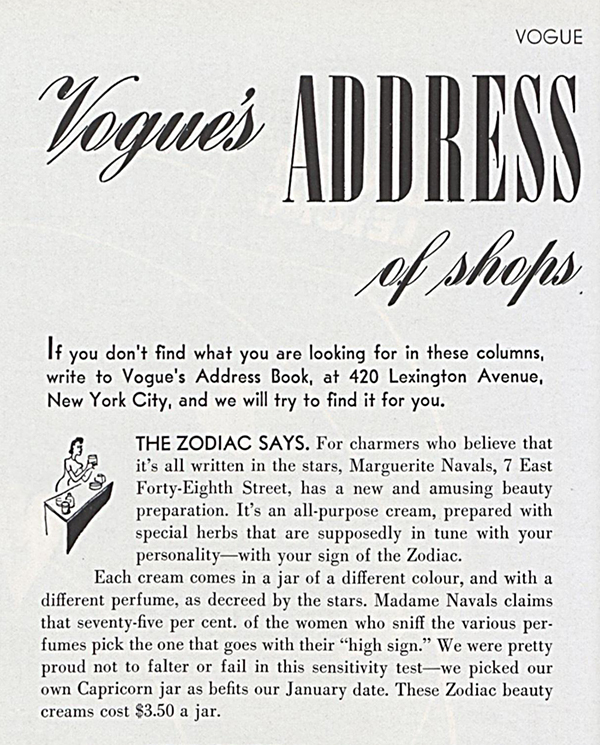
(image from archive.vogue.com)
As compact sales grew exponentially in the '30s and '40s, zodiac-themed cases offered an alternative to monogramming in terms of customization.
The short-lived Ziegfeld Girls brand launched lucite zodiac compacts in 1946, which you can read more about here.
Why this Scorpio compact included a brochure for Capricorn I don't know, but it's interesting to see.
Just two years later Elgin American got in on the zodiac compact game by introducing their "Zany Zodiac" line. The illustrations and rhymes were devised by Stan MacNiel, a Scotsman and former British army captain. He was quite the character and I encourage you to check out my post on him and the Elgin line.
Advertising for both the Ziegfeld Girls and Elgin American compacts emphasize the individualization aspect of the zodiac. Despite the millions of people that share the same sign, zodiac compacts were "all about you" and "individually styled."
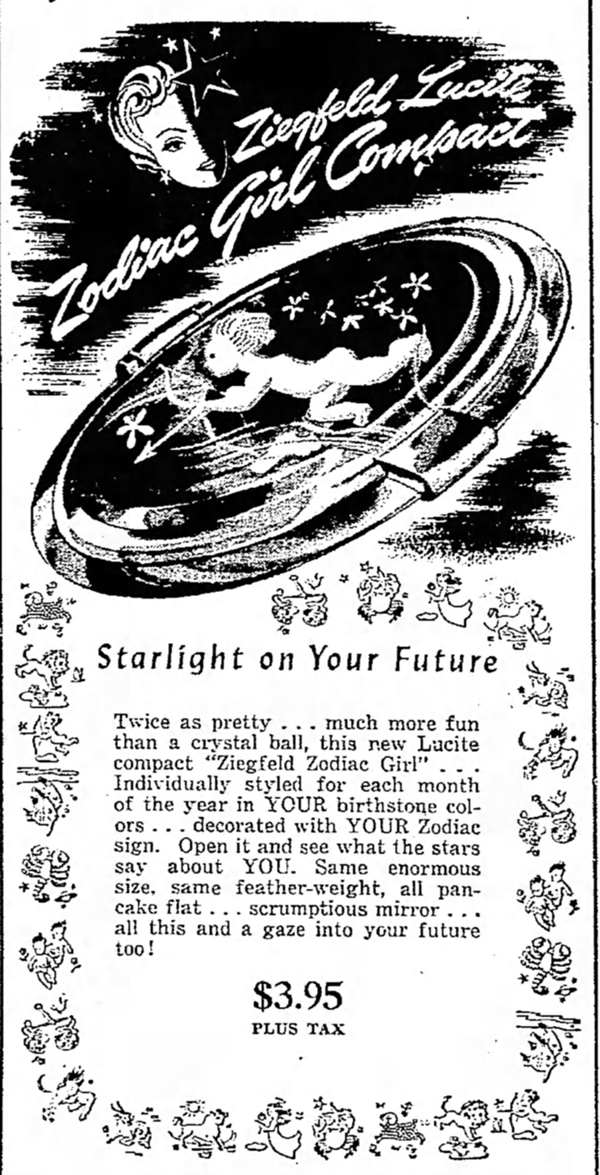
(images from newspapers.com)
As monogrammed compacts gradually became less popular by the mid-20th century, so too did those bearing individual signs. A shift towards including all twelve symbols became more common.
Zodiac-themed compacts from the '50s though the early '70s tended to include all the sun signs.
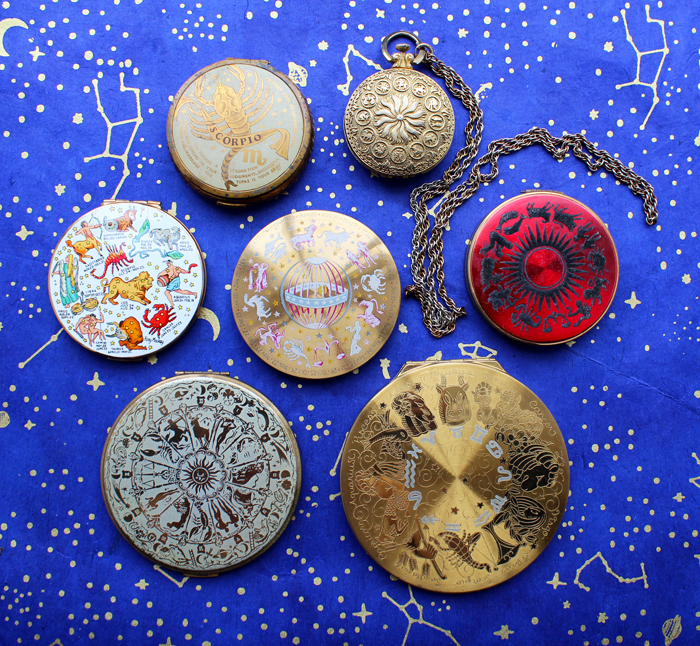
The late 1960s, with its tumultuous social revolution and economic and political uncertainty, is when the astrology craze firmly took hold in American culture. This in turn led to not only zodiac-themed collections but a slew of beauty horoscopes.
 (image from newspapers.com)
(image from newspapers.com)
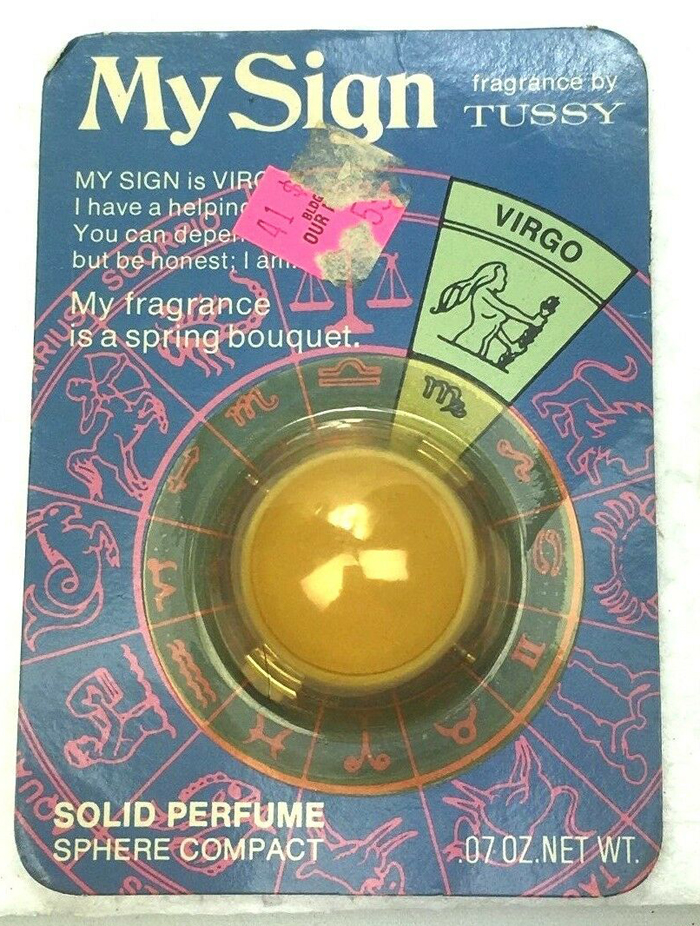
(image from ebay)
Flori Roberts debuted what might have been the first zodiac-inspired line for black women in 1973.
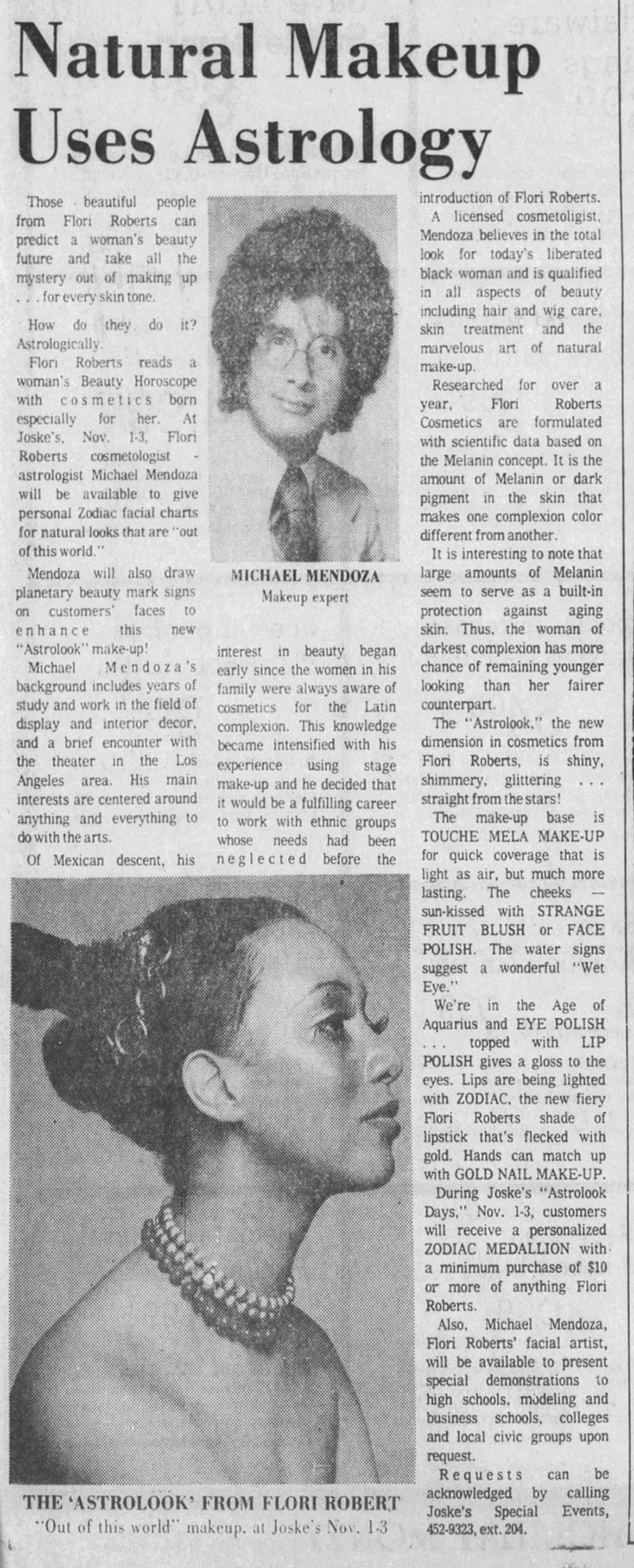 (images from newspapers.com)
(images from newspapers.com)
Actress Arlene Dahl, who had been penning beauty horoscopes since 1963, published her "Beauty Scope" books in 1969. I need to get my hands on a couple copies but in the meantime check out this blogger's review.
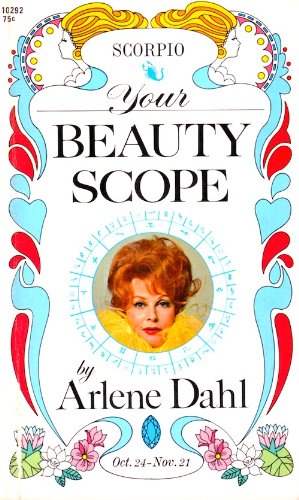
(image from amazon)
Not to be outdone, modeling agency founder John Robert Powers and beauty columnist Jennifer Anderson followed suit.
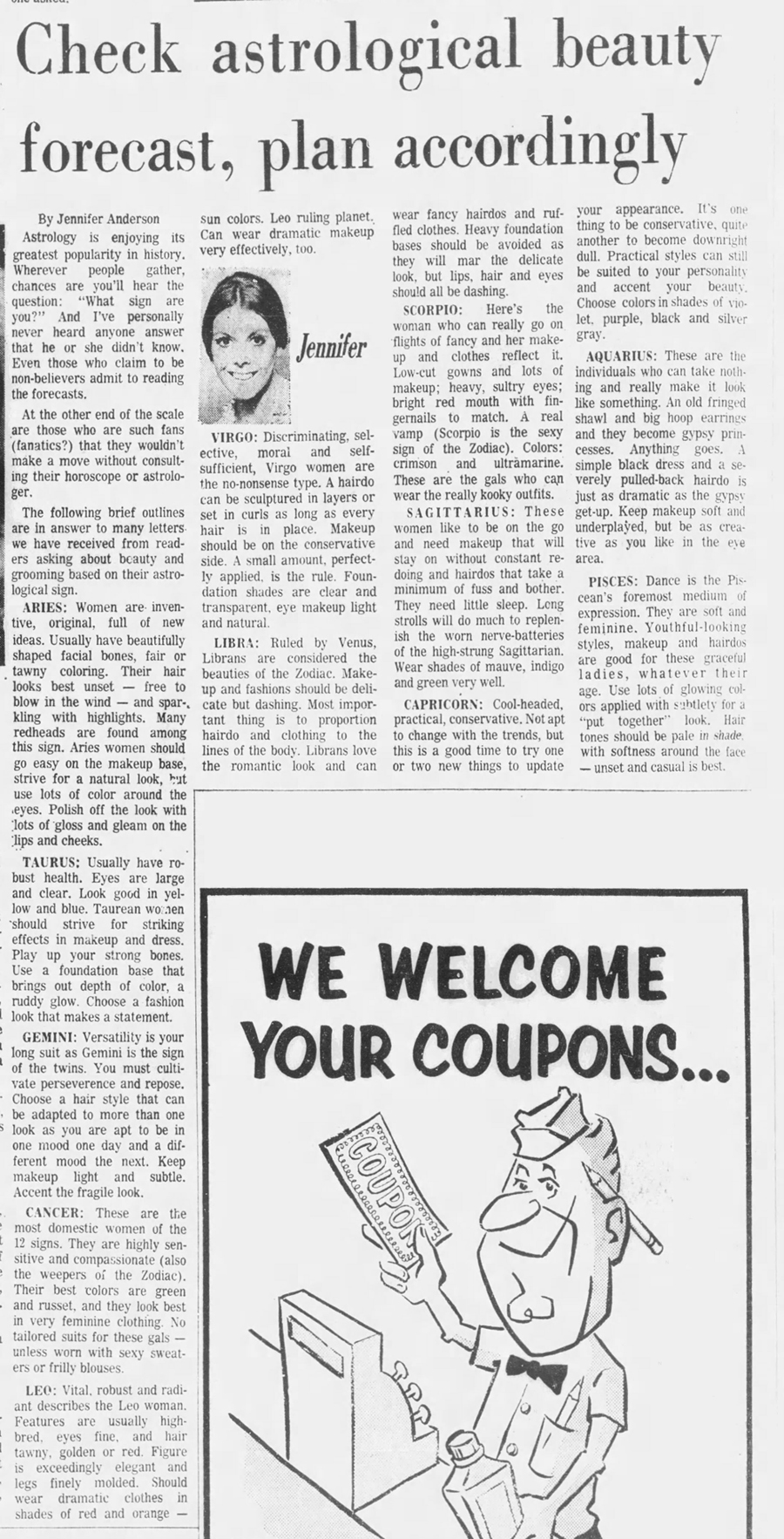 (image from newspapers.com)
(image from newspapers.com)
Some beauty companies took a different, less labor-intensive route than producing and marketing zodiac-themed collections: they began recommending products from their existing lineup for each sign.
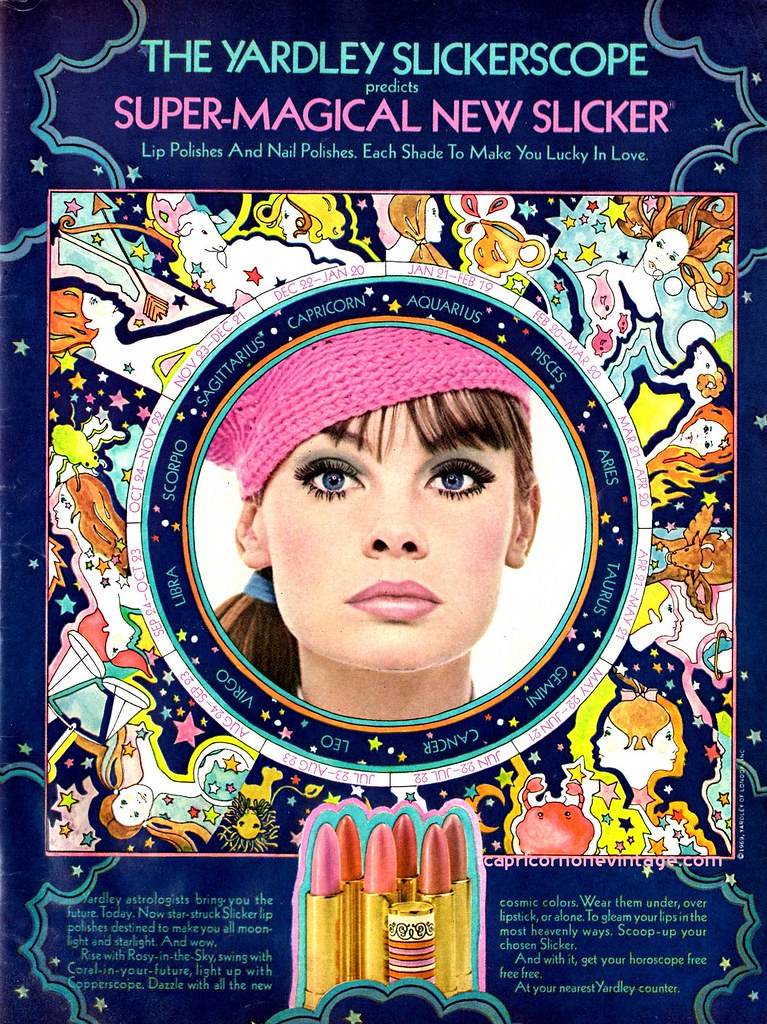 (image from capricornonevintage on flickr)
(image from capricornonevintage on flickr)
 (images from newspapers.com)
(images from newspapers.com)
As the astrology fad waned in the mid-late '70s, due in part to scientist killjoys, so too did zodiac beauty. Save for this 1978 Maybelline ad, I was hard pressed to find any other zodiac-themed makeup until the mid '80s.
Zodiac beauty got a little boost during the greed-is-good era, when makeup artist Linda Mason published a book entitled Sun Sign Makeovers in 1985. Like Dahl's series, the book offered specific beauty tips and makeup looks for each sign. Just a couple years afterwards, Mason released her own line of astrology-inspired makeup called Elements, some of which can still be purchased today (with different packaging). There was a "moodkit" for each sign and specialized kits for eyes, cheeks and lips. By the way, in looking these up and learning more about Mason I discovered that her work is exactly one of the main things the Museum is intended for: the intersection of art and makeup. If travel is ever remotely safe again I'm definitely going to check out her store/art gallery in Soho, it sounds dreamy! It's literally called The Art of Beauty.
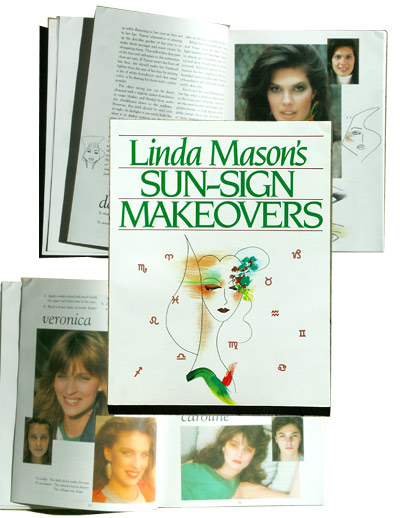
(image from lindamasonprofessional.com)
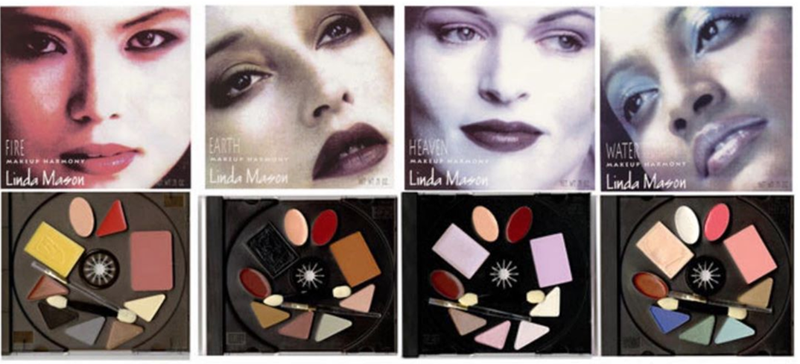 (image from picuki.com)
(image from picuki.com)
Maybelline also tried to re-ignite the zodiac beauty flame in 1988 with individual eyeshadows. First lady Nancy Reagan regularly consulted an astrologer during her husband's tenure, a fact made public that same year, so perhaps this news snippet isn't too far off base. (The shades are listed above in a separate clip for reference.)
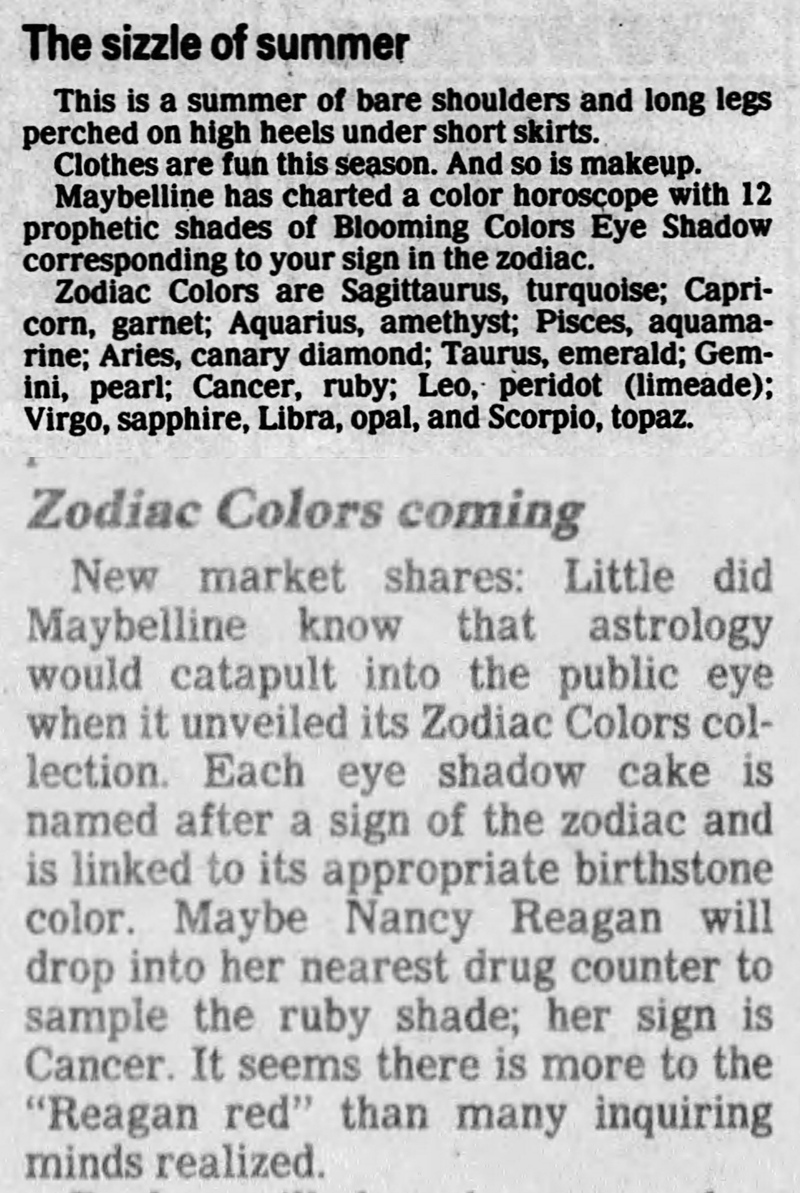
(image from newspapers.com)
The '90s and early 2000s experienced a resurgence of zodiac-themed beauty. Nostalgia for '60s counterculture (in which the fascination with astrology played a big role) as well as the renewed interest in customized beauty products were the major drivers of the trend. While Estée Lauder's compacts – another you can still buy today! – were geared more towards adults, many zodiac-themed products seemed to be intended for teens.
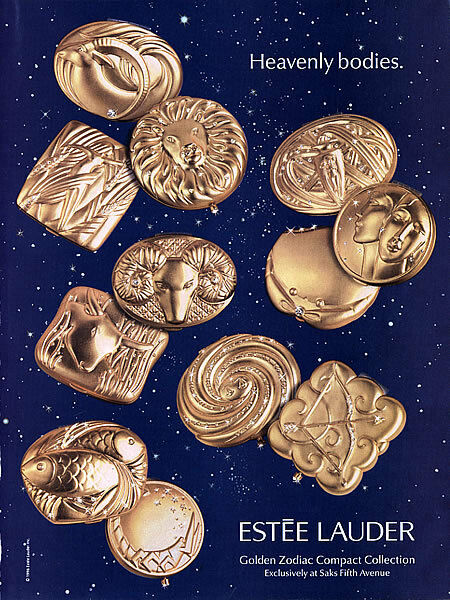
(image from ebay)
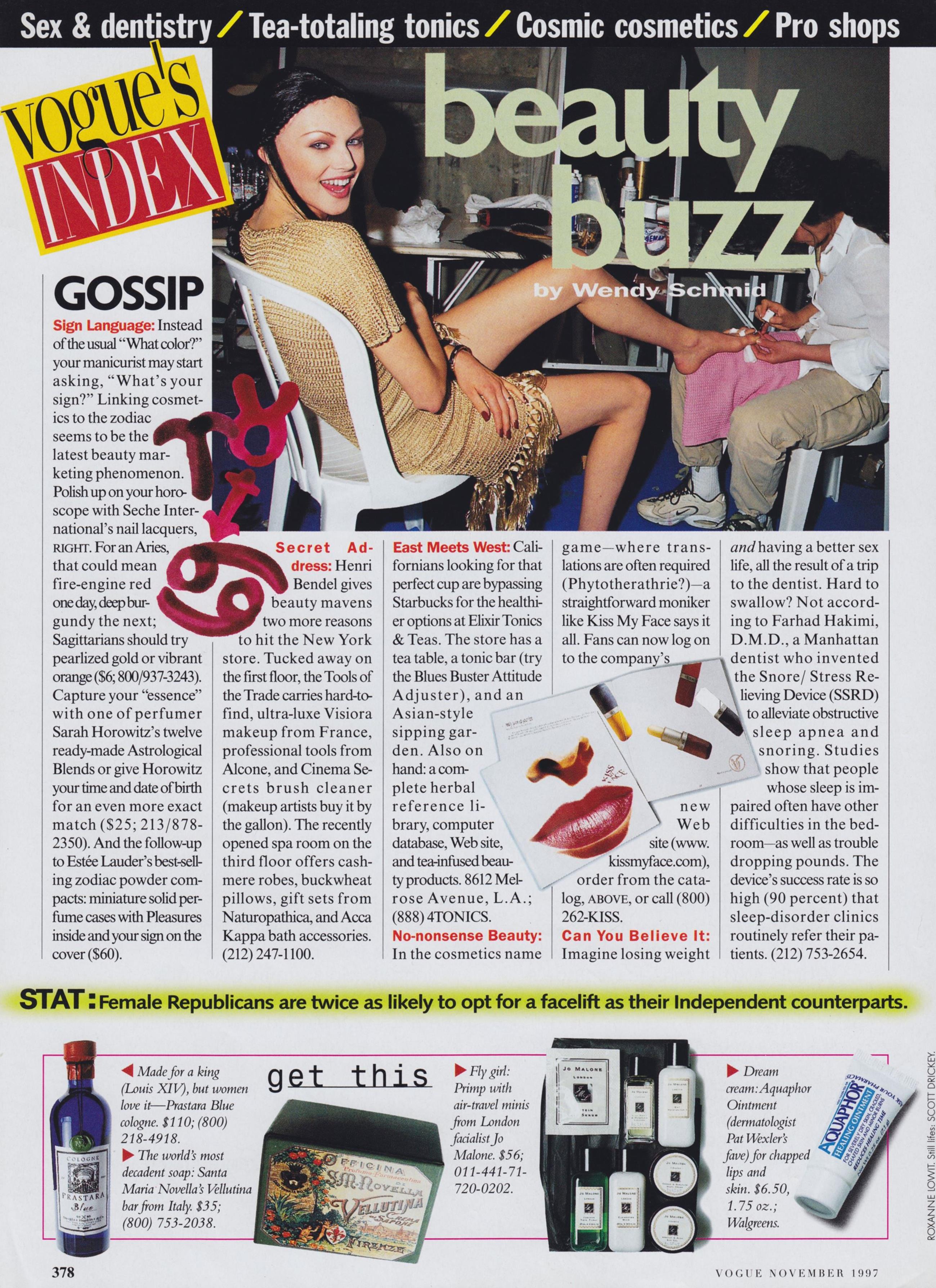 (image from archive.vogue.com)
(image from archive.vogue.com)
Has anyone ever heard of Scotty Ferrell? I could not find a single other reference to him anywhere.
 (image from newspapers.com)
(image from newspapers.com)
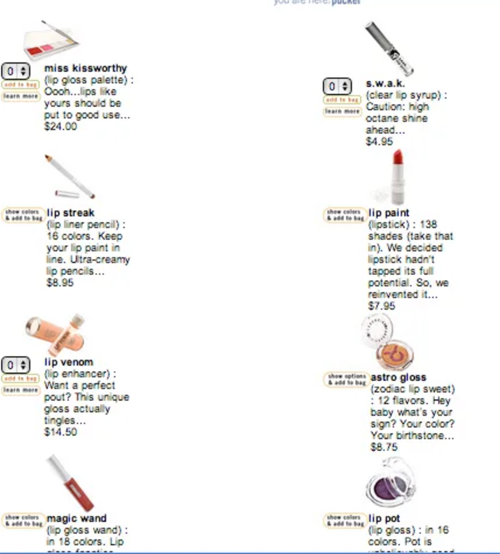
(image from sickmalls.wordpress.com)
Demonstrating that beauty trends are cyclical, the zodiac fad waned again in the late aughts and early 2010s. But around rumblings began in 2015 with Fresh's zodiac soaps and crescendoed to a roar by 2018. Both Fresh and Bite borrowed a page from Flori Roberts and collaborated with noted astrologers for their collections – Susan Miller in the case of Fresh and Tara Greene for Bite.
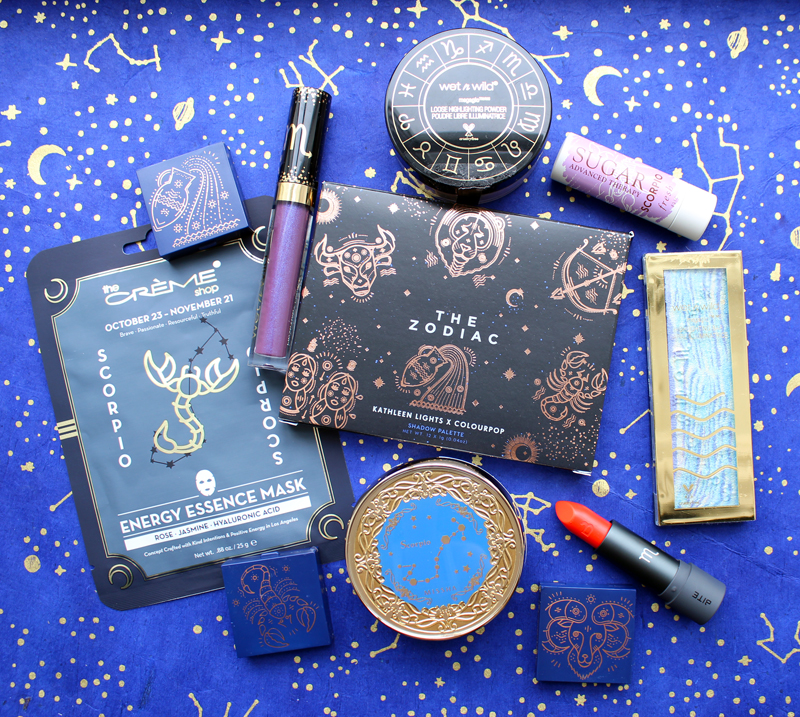
But wait, there's more! These are the ones not in the Museum's collection but still worth a mention. The Milk Makeup zodiac stamps are a thoroughly modern twist on the beauty patches idea from several centuries ago, no? When applied on the face I'd imagine they'd look like beauty marks, albeit ones with a highly specific design.
- Julep zodiac nail polish, fall 2016
- Milk Makeup Astrology tattoo stamps, fall 2018
- Revolution Beauty My Sign eyeshadow palette, 2017
- Demeter Fragrance Library Zodiac Collection, 2016-2017
- BH Cosmetics Zodiac palette, fall 2017
- NCLA zodiac nail polish, 2016
Besides beauty tips and products, the increased usage of social media meant that by 2018 Instagram makeup artists were sharing some very elaborate zodiac looks.
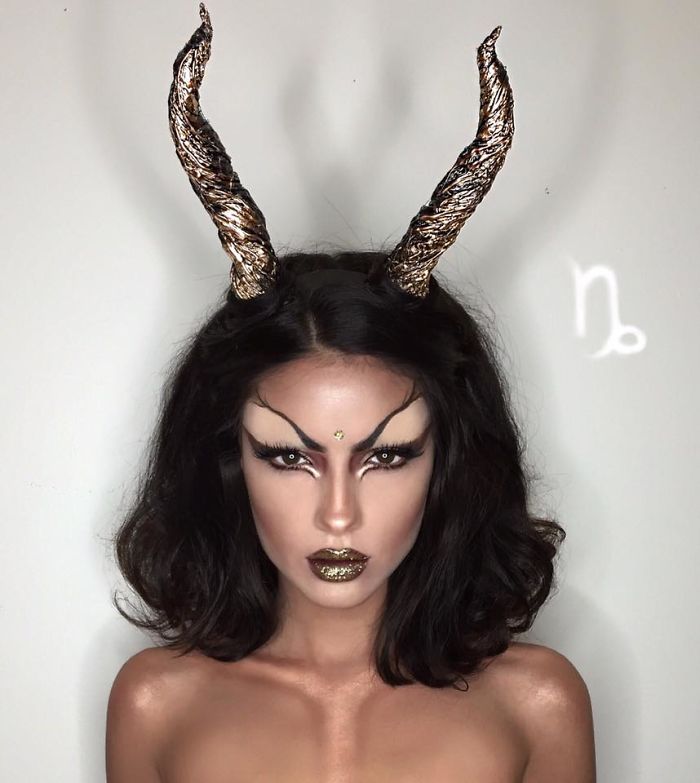
(image from demilked.com)
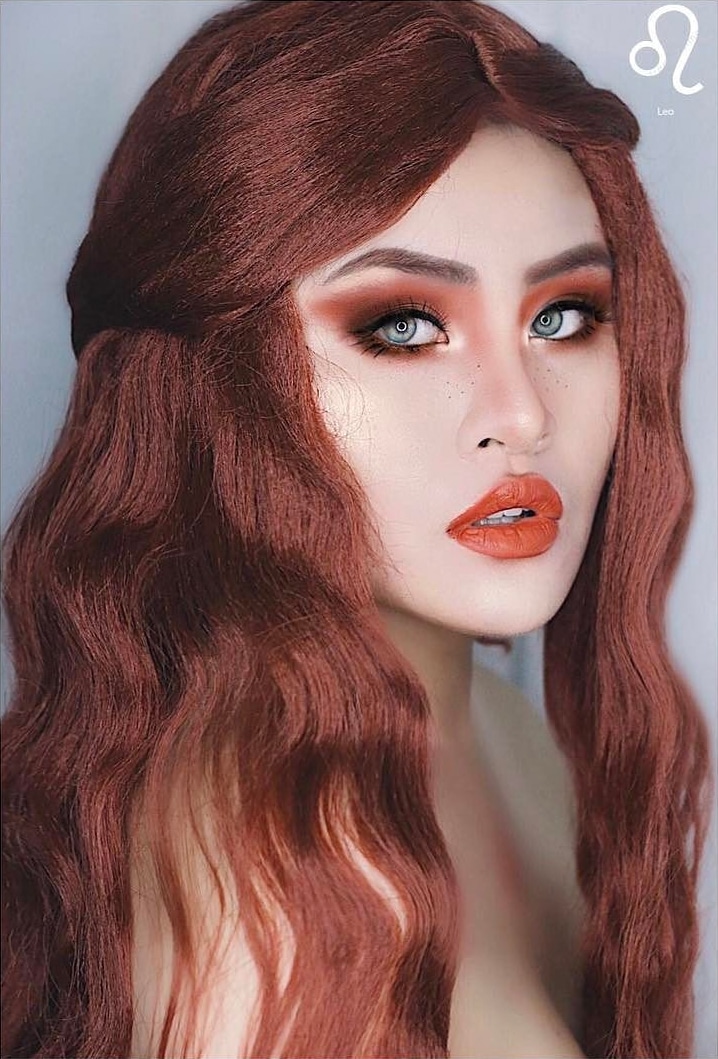
(image from mymodernmet.com)
Lest you think these not-so-wearable looks are solely the creation of 21st century influencers, here's a 1984 Australian beauty pageant where contestants were challenged to come up with the most over-the-top "fantasy" zodiac makeup.
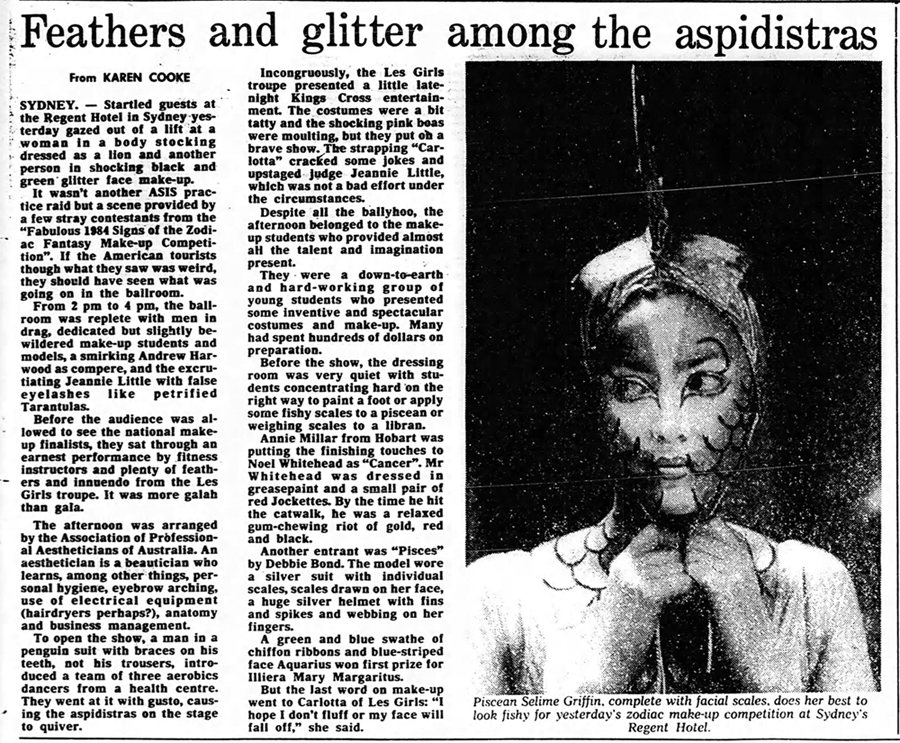 (image from newspapers.com)
(image from newspapers.com)
The packaging and design of all of these objects and looks are interesting in their own right, but why does zodiac makeup trend more at certain times? And why is it experiencing what may be the peak of popularity during the past 2 years? There are several reasons. First, zodiac-themed beauty tends to follow a wider cultural interest in astrology and New Age practices more generally (crystals, tarot cards, etc.). Businesses are always eager to profit from the latest fad, and the beauty industry is no exception. The "mystical and psychic services market" was worth $2.2 billion in 2019 according to this trend forecaster. As Saffron of the Beauty Critic points out, astrology-themed makeup fits within the broader context of New Age/occult-inspired beauty and wellness products we're seeing now as a result. And in the Age of Aquarius, companies introduced hundreds of zodiac-themed products. Linda Goodman's 1968 Sun Signs was the first book on astrology to become a New York Times bestseller; by 1971, astrology was a $200 million dollar a year business in the U.S.2 Even Dali got in on the action.
The interest in astrology points to larger societal shifts and is driven primarily by younger generations just as it was some 50 years ago.3 Millennials and Generation Z are reporting higher rates of stress than older generations, and are increasingly turning to astrology and other New Age phenomena to cope. As the Atlantic explained in 2018, "According to American Psychological Association survey data, since 2014, Millennials have been the most stressed generation, and also the generation most likely to say their stress has increased in the past year since 2010. Millennials and Gen Xers have been significantly more stressed than older generations since 2012. And Americans as a whole have seen increased stress because of the political tumult since the 2016 presidential election. The 2017 edition of the APA’s survey found that 63 percent of Americans said they were significantly stressed about their country’s future. Fifty-six percent of people said reading the news stresses them out, and Millennials and Gen Xers were significantly more likely than older people to say so. Lately that news often deals with political infighting, climate change, global crises, and the threat of nuclear war. If stress makes astrology look shinier, it’s not surprising that more seem to be drawn to it now." Case in point: this "stress-busting" insert from a recent Sephora Play! box detailing what beauty products will help with relaxation based on one's sign.
The decline of organized religion and the expansion of the Internet's capabilities are also factors in astrology's revival.3 In 1972 one journalist cited two key reasons for the surge in astrology's rise: "fear in an uncertain time and the failure of orthodox religion to give meaning to problems."4 The same can be said for today's environment. Jessica Roy, writing for the L.A. Times in 2019, details the shift away from traditional religion and the resulting turn towards astrology. "Today, young people still seek the things that traditional organized religion may have provided for their parents or grandparents: religious beliefs, yes, but also a sense of community, guidance, purpose and meaning. But it can be hard for young people to find those things in their parents’ religions. So they’re looking elsewhere. On top of that, a lot of younger people feel alienated by mainstream religion — by attitudes toward LGBTQ people and women, by years of headlines about scandals and coverups, or by the idea that anyone who isn’t part of that religion is inherently bad or wrong…Before the internet, people who held beliefs outside the mainstream — religious, political or otherwise — lacked a public way to connect with one another. With social media, divinatory practices like astrology, crystals and tarot have been able to take up space in a public conversation. It helps that they all look great on Instagram…Young people have grown up contending with a major recession, climate change and a more general awareness of seeing a political and economic system that many feel hasn’t benefited them, so it’s not surprising that they’re pushing back against those systems at the same time they’re exploring nontraditional religious beliefs and finding ways to integrate it all."
As for modern technology, the New Yorker further lays out how the Internet and social media allowed astrology to be more accessible and at a much faster pace than before. "[Astrology] promises to get to answers more quickly. For centuries, drawing an astrological chart required some familiarity with astronomy and geometry. Today, a chart can be generated instantly, and for free, on the Internet. Astrology is ubiquitous on YouTube, Facebook, Instagram, and Twitter, and in downloadable workshops, classes, and Webinars. A new frontier has opened with mobile apps." While the Internet has radically changed, well, everything, in 1970 some of the first computers were being used to generate horoscopes, with companies pouring millions into new technology just as they are now for the same reason – increased speed of delivery to meet demand.
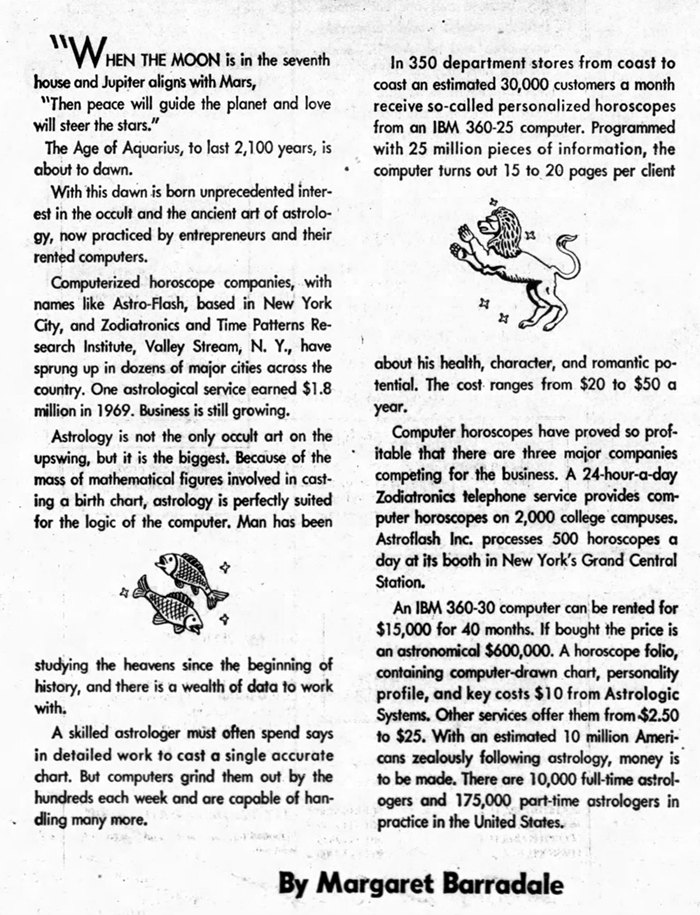 (image from newspapers.com)
(image from newspapers.com)
The second major factor in zodiac beauty's ubiquity is customization. Consumers like to think they're getting a product made or intended just for them. Customization in beauty is trending more heavily than ever before, from nearly every company offering engraving services to personal consultation apps. And astrology is a fairly simple way to advertise a seemingly individualized product. In an interview with WWD, Fresh's chief marketing officer highlighted the trend of "customization and personalization" in the industry. She also noted that "the collaboration was particularly successful in China, which she attributed to Chinese Millennials and their obsession with the zodiac." It's a great point about Chinese zodiac beauty products as there's been an equally explosive rise in lunar new year-themed beauty products in the past few years, many of them depicting the animal corresponding to the year. (See also Shiseido's Chinese zodiac figurines.)5 I think the growing interest in C-beauty is also partially responsible.
The customized aspect of zodiac-themed beauty parallels the personalization options in astrology and other New Age trends. One doesn't have to become a certified astrologer to enjoy horoscopes; they can pick and choose whatever suits them. Roy again: "[Millennials] dabble, they find what they like, they take what works for them and leave the rest…spiritual practices appeal to the commitment-wary: You can get a little into crystals or astrology or tarot, or a lot into it. You can buy a few rose quartzes or light a few candles and if it’s meaningful for you, keep it; if not, it’s not like you went through a full religious conversion."
As noted earlier, another time that was popular for customization was the "golden age" of compacts in the '40 and '50s, where many were engraved as personalized gifts or event keepsakes. Some were even designed with spaces specifically to add monograms. Perhaps that explains why two major compact manufacturers decided to add to their repertoire with zodiac lines.
Finally, on a more basic level, the visual appeal of zodiac imagery is fairly irresistible. There are as many different ways to depict zodiac signs as there are artists. Whether it's the caricatures illustrated by Stan MacNiel for Elgin, the refined style of Poudre d'Orsay, or the minimalist approach taken by Demeter, even if customers aren't astrology fans the designs will draw them in. In looking at the Museum's zodiac collection one would suspect I obsessively read horoscope predictions and plan my life around the alignments of stars and planets, but I'm actually not into astrology. I check out my horoscope from time to time just for fun, but the reality is that I collect zodiac makeup mostly because I enjoy looking at the artwork. The fact that it's prominent in makeup history and belongs in a museum is, admittedly, simply an added bonus. The otherworldly nature of the creatures and constellations combined with the twelve symbol structure satisfies both the imagination and the need for orderliness. Plus as a former art history major, it's fascinating to see different artists' takes on the zodiac.
What object here is your favorite? Would you ever try a makeup look or product based on your sign?
1Aileen Ribeiro, Facing Beauty, Yale University Press, 2011, p. 132.
2Barbara Holsopple, "A Longing for Things to Be Put Right", Pittsburgh Press, April 4, 1971.
3It's out of print, but if you're interested I bet this book is great if you're looking specifically for a cultural history of astrology. Or at least, it was the only one I could find.
4Mary Turczyn, "What is the Occult?", Fond du Lac Commonwealth Reporter, March 22, 1972. She adds, "In a poll taken in 1967, 57% said that religion was losing its influence on American life. With religion no longer the bulwark of society, people seek answers in other areas and astrology has rallied as one of these."
5For the purposes of expediency and so as not to be all over the place I chose to focus on the modern, Western zodiac rather than exploring the Chinese zodiac in beauty products. I do wonder how far back it goes…I'm envisioning powder containers hundreds of years old in the shape of dragons and other Chinese zodiac animals. Must research!


